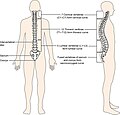Laminotomy
Laminotomy is a neurosurgical procedure that involves the removal or trimming of a portion of the vertebral bone called the lamina. The procedure is performed to alleviate pressure on the spinal cord or spinal nerves, which can be caused by conditions such as spinal stenosis, herniated disc, or spinal tumors.
Procedure[edit]
A laminotomy is performed under general anesthesia. The surgeon makes an incision in the back over the affected area. Using specialized tools, the surgeon removes or trims a portion of the lamina to create more space for the spinal cord or nerves. The incision is then closed with sutures.
Indications[edit]
Laminotomy is indicated for conditions that cause pressure on the spinal cord or nerves. These conditions include spinal stenosis, herniated disc, and spinal tumors. Symptoms of these conditions can include back pain, sciatica, numbness or weakness in the limbs, and difficulty walking.
Risks and Complications[edit]
As with any surgical procedure, laminotomy carries risks. These can include infection, bleeding, nerve damage, and complications from anesthesia. There is also a risk that the procedure may not alleviate the symptoms.
Recovery[edit]
Recovery from a laminotomy can take several weeks. Physical therapy may be recommended to help regain strength and mobility. Pain medication may also be prescribed to manage post-operative pain.
See Also[edit]
This neurosurgery related article is a stub. You can help WikiMD by expanding it.
-
Laminotomy
-
Laminotomy
-
Laminotomy
-
Laminotomy
-
Laminotomy
-
Laminotomy
Ad. Transform your life with W8MD's Budget GLP-1 injections from $75


W8MD offers a medical weight loss program to lose weight in Philadelphia. Our physician-supervised medical weight loss provides:
- Weight loss injections in NYC (generic and brand names):
- Zepbound / Mounjaro, Wegovy / Ozempic, Saxenda
- Most insurances accepted or discounted self-pay rates. We will obtain insurance prior authorizations if needed.
- Generic GLP1 weight loss injections from $75 for the starting dose.
- Also offer prescription weight loss medications including Phentermine, Qsymia, Diethylpropion, Contrave etc.
NYC weight loss doctor appointmentsNYC weight loss doctor appointments
Start your NYC weight loss journey today at our NYC medical weight loss and Philadelphia medical weight loss clinics.
- Call 718-946-5500 to lose weight in NYC or for medical weight loss in Philadelphia 215-676-2334.
- Tags:NYC medical weight loss, Philadelphia lose weight Zepbound NYC, Budget GLP1 weight loss injections, Wegovy Philadelphia, Wegovy NYC, Philadelphia medical weight loss, Brookly weight loss and Wegovy NYC
|
WikiMD's Wellness Encyclopedia |
| Let Food Be Thy Medicine Medicine Thy Food - Hippocrates |
Medical Disclaimer: WikiMD is not a substitute for professional medical advice. The information on WikiMD is provided as an information resource only, may be incorrect, outdated or misleading, and is not to be used or relied on for any diagnostic or treatment purposes. Please consult your health care provider before making any healthcare decisions or for guidance about a specific medical condition. WikiMD expressly disclaims responsibility, and shall have no liability, for any damages, loss, injury, or liability whatsoever suffered as a result of your reliance on the information contained in this site. By visiting this site you agree to the foregoing terms and conditions, which may from time to time be changed or supplemented by WikiMD. If you do not agree to the foregoing terms and conditions, you should not enter or use this site. See full disclaimer.
Credits:Most images are courtesy of Wikimedia commons, and templates, categories Wikipedia, licensed under CC BY SA or similar.
Translate this page: - East Asian
中文,
日本,
한국어,
South Asian
हिन्दी,
தமிழ்,
తెలుగు,
Urdu,
ಕನ್ನಡ,
Southeast Asian
Indonesian,
Vietnamese,
Thai,
မြန်မာဘာသာ,
বাংলা
European
español,
Deutsch,
français,
Greek,
português do Brasil,
polski,
română,
русский,
Nederlands,
norsk,
svenska,
suomi,
Italian
Middle Eastern & African
عربى,
Turkish,
Persian,
Hebrew,
Afrikaans,
isiZulu,
Kiswahili,
Other
Bulgarian,
Hungarian,
Czech,
Swedish,
മലയാളം,
मराठी,
ਪੰਜਾਬੀ,
ગુજરાતી,
Portuguese,
Ukrainian






